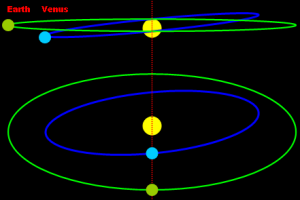Today Is Your Last Chance This Lifetime to See Venus Pass in Front of the Sun
Venus’ next transit of the sun isn’t until 2117—so read about what to watch for and make sure to look to the skies
/https://tf-cmsv2-smithsonianmag-media.s3.amazonaws.com/filer/Venus-Transit-hero.jpg)
Every century or so, something truly special happens in the sky, and it happens twice: Venus passes in between the sun and earth. The transit of Venus, as it’s called, comes in pairs spaced exactly 8 years apart, with each pair separated by gaps more than 100 years long. As a result, only 8 transits have occurred since the invention of the telescope.
The most recent one was in 2004, and the second half of the pair is next week, during sunset on June 5th for North American observers, and during sunrise on June 6th for many in Europe and Asia. After this, the next one isn’t until 2117.
Why does it happen so rarely? Two events need to occur at the exact same time for us to see a transit of Venus. First, Venus needs to pass between us and the sun, so that to an observer looking down at the solar system, all three bodies would be in a straight line. This happens every 584 days, as shown in the bottom part of the diagram below.

Transits of Venus are so rare because the planet must pass between earth and the sun while lining up vertically, as well
However, Venus also needs to line up vertically so that it appears somewhere in front of the face of the sun from our vantage point. Because Venus and the earth don’t orbit the sun on the exact same plane—Venus’ orbit is tipped 3.4 degrees relative to ours—most of the time it’s too high or too low, as shown in the top part of the diagram. It only lines up in all 3 dimensions and traverses across the sun four times during an unusual 243 year cycle, with the transits coming in pairs separated by alternating periods of 121.5 and 105.5 years.
In the United States, the transit will begin at roughly 6:04 Eastern, 5:04 Central, 4:05 Mountain, and 3:06 Pacific Time. Over the course of several hours, Venus will appear as a small dot moving slowly against backdrop of the sun. As with a solar eclipse (or anytime, really), looking directly at the sun can severely damage your retinas, so you should use a special filter or simply project the sun onto the ground or a piece of paper, by holding up a piece of cardboard with a small hole punched in it and allowing the sunlight to pass through.
Historically, the transit of Venus played an important role in helping astronomers learn about the dimensions of our solar system, says Owen Gingerich, professor of astronomy and history of science at the Harvard-Smithsonian Center for Astrophysics. “The first observed transit was in 1639, but it was in 1716 that the astronomer Edmund Halley noticed that the geometry of it could be useful in determining the distance to the sun,” he says. “At the time, the relative distances between the planets was well known, but not the absolute scale of the solar system, and without the absolute scale, you couldn’t know how big the sun was.”
When the next pair of transits came, in 1761 and 1769, the scientific world was ready. “There was an international campaign set up to make the observations, and you needed observers from as far removed places on earth as you could get,” says Gingerich. Scientists were dispatched to everywhere from Newfoundland to Tahiti to gather as much data as possible, and at each location, observers attempted to measure as accurately as possible just how long it took Venus to traverse the sun.
As Halley had pointed out, if one knew the exact distance between two points on earth—Newfoundland and Tahiti, for example—and also calculated the difference in how long it took Venus to traverse the sun from each of these vantage points, the principle of parallax could be used to determine the size of the sun itself, and with that our distance from it. “From each observatory, you would get a slightly different measurement for the length of Venus’ path,” Gingerich says. “And in fact, if you take three of the best observations from 1769 and use them in the calculations, you get a result within 1 percent of the modern value of the size of the sun.”
Although the transit is no longer as scientifically significant as it was in the 18th century, it will still provide valuable data for many observers. Our ongoing discoveries of planets in other solar systems, for example, depends on the intermittent dimming of distant stars as their planets pass in front of them. Calculating just how much Venus causes the sun to dim during the transit might help us more accurately understand these far-flung exoplanets.
Whether you watch the transit to make complex calculations about exoplanets or just to see something unusual in the sky, we have just one recommendation: You’d better not miss it. The next few transits will be in December 2117, December 2125, June 2247 and June 2255. Your grandchildren and great-grandchildren might be watching, but you won’t be around to see another one.
/https://tf-cmsv2-smithsonianmag-media.s3.amazonaws.com/accounts/headshot/joseph-stromberg-240.jpg)
/https://tf-cmsv2-smithsonianmag-media.s3.amazonaws.com/accounts/headshot/joseph-stromberg-240.jpg)